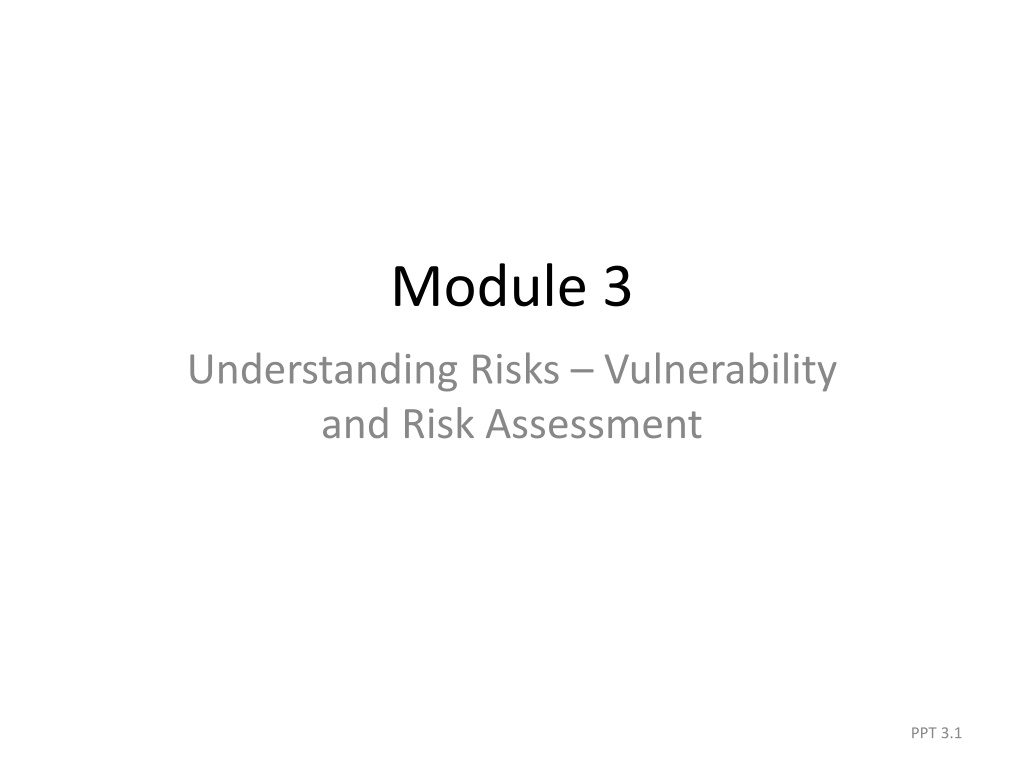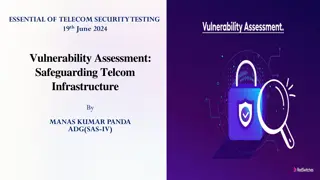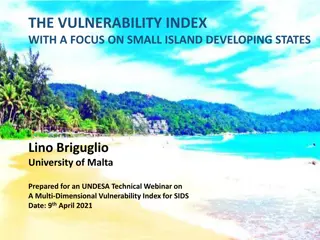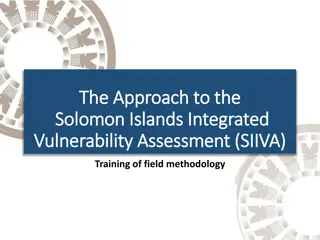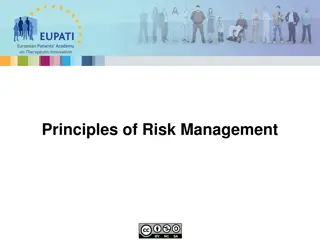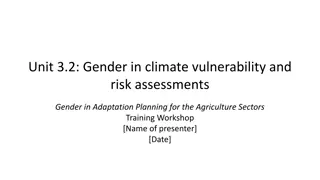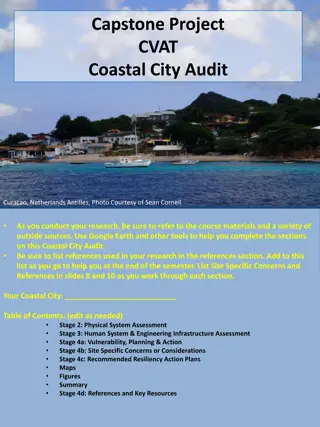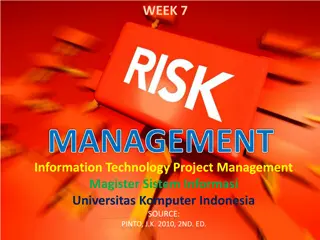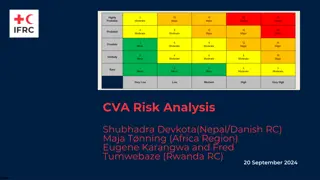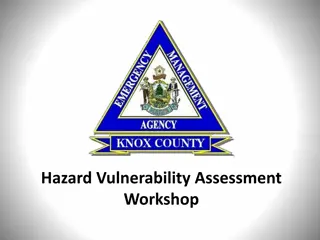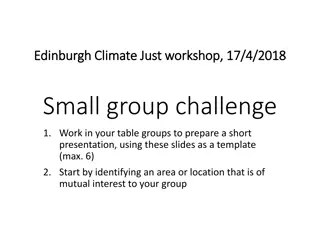Understanding Risks and Vulnerability in Risk Assessment
This module focuses on understanding risks, vulnerability, and conducting risk assessments in disaster risk management. It covers terminologies such as threats, hazards, vulnerability, and exposure, essential for prioritizing risks and initiating risk reduction measures.
Uploaded on Sep 27, 2024 | 0 Views
Download Presentation

Please find below an Image/Link to download the presentation.
The content on the website is provided AS IS for your information and personal use only. It may not be sold, licensed, or shared on other websites without obtaining consent from the author. Download presentation by click this link. If you encounter any issues during the download, it is possible that the publisher has removed the file from their server.
E N D
Presentation Transcript
Module 3 Understanding Risks Vulnerability and Risk Assessment PPT 3.1
Module 3: Performance Objectives At the end of this module, the trainees will be able to: explain vulnerability and risk elements of a threat and how to conduct vulnerability and risk assessment of threats Carry out vulnerability and risk assessment of threats more likely to happen in their respective administrations to prioritise risks and to take appropriate risk reduction and preparedness initiatives in the DRM Plan PPT 3.2
Activities in this Module Go through the presentations Carry out vulnerability and risk assessments of various threats relating to trainees respective administrations Complete Progress Test Q 3.1 PPT 3.3
Terminologies in Vulnerability & Risk Assessment Before undertaking vulnerability assessment, it is important to understand some terminologies used in this assessment and how they are inter-connected? Threat: It is a potentially damaging event that can occur and has a detrimental impact on the economy. Postal administrations regularly face many threats, both natural and man-made. Threats, when they actually materialise, become hazards or disasters. and risk PPT 3.4
Terminologies (contd.) Hazard: It is any phenomenon or situation, which has the potential to cause disruption or damage to people, property, environment. E.g., Earthquake, Flood, Terror Attacks. When the disruptions or damage are severe, hazards become disasters. Hazards are the sources of risks. They create risks. PPT 3.5
Terminologies (contd.) Vulnerability It is a set of conditions which increase susceptibility (meaning chance of getting harmed) to physical, economic losses from the impact of natural disasters. Example: Post Offices located in flood zone are vulnerable to the risk of being harmed during floods PPT 3.6
Terminologies (contd.) Exposure The situation of people, infrastructure, production facilities, operative offices and other assets located in hazard prone areas. If more people and assets are exposed, higher is the vulnerability. PPT 3.7
Terminologies (contd.) Risk Risk is defined as the probability of harmful consequences or expected losses resulting from interactions between natural hazards and vulnerable conditions. PPT 3.8
Understanding Risk - The Risk Triangle Risk is a combination of the interaction of hazard, exposure and vulnerability, which can be represented by the three sides of a triangle. Risk Vulnerability PPT 3.9
Understanding Risk - The Risk Triangle (contd.) If any of these sides increases, the area of increases, hence the amount of risk also increases the triangle Risk If any of the sides reduces, the risk reduces Vulnerability PPT 3.10
Understanding Risk (contd.) Risk is a statistical concept. It is defined as: Probability of a threat occurring multiplied by Expected impacts from the threat. Considering both probability of occurrence of various threats and the expected impacts from these threats, postal administrations can classify various threats as high-risk threats, low-risks threats etc through a Risk Grid. The Risk Grid is explained below. PPT 3.11
Risk Grid Identification of various threats and then subsequently their classification through a Risk Grid is a very effective approach in disaster risk management. The Grid helps managers to find out the top-risk threats (high-risk high-impact scenario), to focus on them and to prioritise risk mitigation and preparedness measures to face them. A Risk Grid is shown in the next diagram. PPT 3.12
Risk Grid Expected impacts LOW RISK HIGH IMPACT HIGH RISK HIGH IMPACT LOW RISK LOW IMPACT HIGH RISK LOW IMPACT Probability of a threat occurring (risk) PPT 3.13
Risk Grid (contd.) For classification of threats through a Risk Grid, postal administrations need to estimate (a) the probability of occurrence (likelihood) of the threats (b) the expected impacts from these threats. Vulnerability & Risk Assessment of the threats help to estimate the impacts. PPT 3.14
How to Conduct the Vulnerability and Risk Assessment Three tasks are to be completed for this: 1. Collect data of hazards that happen in your administration and find out about their Frequency magnitude & location This will help to estimate which hazards (or say, threats) and locations have higher risks or probability of occurrence PPT 3.15
Vulnerability & Risk Assessment (contd.) 2. Make a vulnerability assessment to find out all exposed employees and assets to such higher risks hazards. More the number of such exposed elements, higher is the vulnerability and consequently, higher is the expected damage and losses, should a disaster occur PPT 3.16
Vulnerability & Risk Assessment (contd.) 3. Make a Risk Assessment to estimate possible impacts (i.e. damage and losses) from a particular hazard or multiple hazards. To do this: (i) Consider the Hazards (ii) Count the elements at risk, viz. People, Physical Structures (Buildings), Equipment, Vehicles etc. PPT 3.17
Vulnerability & Risk Assessment (contd.) (iii) Assess their vulnerability based on Age, sex, physical disabilities Type of construction of buildings etc. (iv) Estimate potential losses (impacts) of exposed people, property, infrastructure etc. This is Vulnerability and Risk Assessment. PPT 3.18
Vulnerability & Risk Assessment (contd.) Understanding risks through Vulnerability and Risk Assessment (also known simply as Risk Assessment) is essential to the field of DRM. Postal administrations will be able to estimate what and how much risk they face and what actions can be taken in advance. Risk Assessments help managers to classify threats (refer to the following slide) and to prioritise resources & focus efforts on most critical and highest-risk threats. PPT 3.19
Classification of Threats based on Risk Assessments A threat is plotted on a grid considering its (i) probability of occurrence (likelihood) and (ii) expected impacts from that threat (ref. Diagram at PPT 3.13) Other threats can similarly be plotted. Position of the threats can now be seen in the four zones. Threats are thus classified as High-High, High-Low, Low-High and Low-Low threats. Administrations can focus on high-risk threats. PPT 3.20
Risk Assessment Assumptions While making Risk Assessment, the following should be kept in mind to estimate accurately what and how much risks is there and what can be prepared in advance A major emergency or incident can happen at any time with little or no warning Availability of staff and resources may be severely limited during such emergencies Actual or threatened emergencies may adversely affect the ability to perform essential internal operations PPT 3.21
Assumptions (contd.) Emergencies should be managed at local level first Emergencies require cooperation/coordination with first responders and other external entities at the city, province, regional and national levels Basic services like electricity, water, natural gas, heating, telecommunications information systems may be interrupted Buildings and other structures may be damaged Normal suppliers may not be able to deliver goods and other PPT 3.22
Vulnerability and Risk Assessment in your Administration Trainees can now list various threats that their administrations are facing taking into account probability of their occurrence and estimated losses (impacts) from such threats, they can position the threats in four zones of a Risk Grid find out which threats have highest risk (High-Risk High- Impacts) Suggest and write down various risk mitigation and preparedness measures/ activities to face the highest-risk threats [Handout H 3.1 can be used for classification of the threats] PPT 3.23
Progress Test Q 3.1 PPT 3.24
